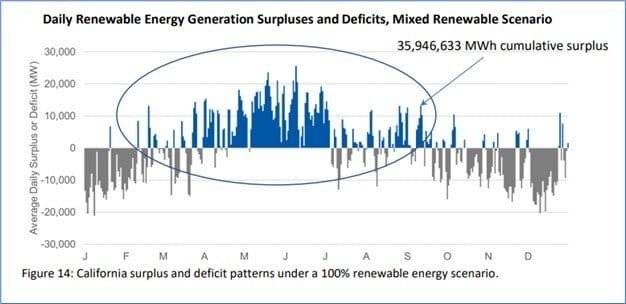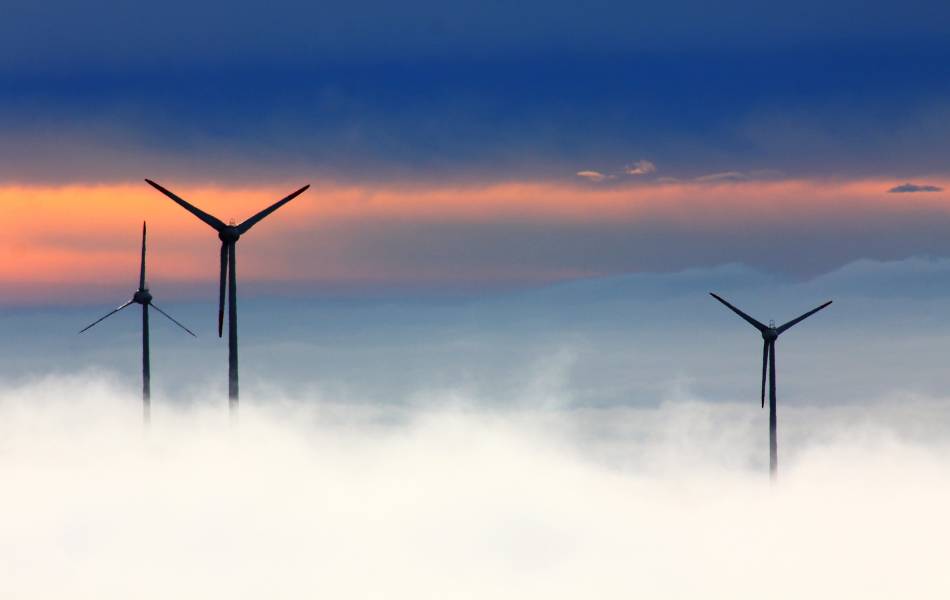California’s government officials are passing laws and regulations that will force Californians to transition most of the state’s energy consumption from fossil fuels (primarily gasoline, diesel fuel, and natural gas) to electricity generated primarily by wind and solar generating facilities. The stated purposes are to reduce California’s net greenhouse gas (GHG) emissions to zero (aka net zero) and to further reduce air pollution.
This policy brief provides an overview of California’s principal green energy laws and regulations and identifies the likely effects of the policies. Readers will discover that the marginal benefits of California’s energy policies are far outweighed by huge new costs, disruptions, intrusions, and risks. Readers will also discover that there are more affordable, and less intrusive ways to protect Californians.
An Overview of California’s Green Energy Policies
California’s government officials are effectively banning the use of fossil fuels that now provide:
- electric power generation
- car and light truck transportation
- heavy (tractor-trailer) truck transportation
- space heating and water heating
Officials have also banned nuclear and large hydroelectric power generation. Exceptionally high taxes on vehicle fuels and industrial carbon emissions have also been enacted.
California’s Renewable Portfolio Standard (RPS) law requires that California investor-owned electric utilities must serve their electric load with renewable energy: 44 percent by 2024, 52 percent by 2027, 60 percent by 2030, and 100 percent by 2045.[1] RPS-eligible resources include solar, wind, geothermal, small hydroelectric, or biopower facilities that are located within the fourteen western U.S. states and portions of Canada and Mexico. The majority of RPS-eligible electricity currently must come from solar and wind. Large hydroelectric facilities (that store water in reservoirs) and nuclear facilities, two current major sources of carbon-free electricity in California, are not RPS-eligible. So nuclear and large hydroelectric generation must also be phased out. While the California RPS law applies only to the state’s large investor-owned electric utilities, the publicly owned electric utilities are generally pursuing similar RPS policies.
New California Air Resources Board (CARB) regulations (partially enacted in 2022 and planned for further enactment in 2023) will forcibly phase out the sale of new fossil-fueled vehicles, space heating furnaces, and water heaters in California over the next two decades.[2] About 50 cities and towns in California, including Los Angeles and San Francisco, have adopted regulations that ban or discourage the use of natural gas-fueled cooking stoves in new buildings.
Transportation and heating will probably be subsequently fueled by electricity. Electric utility grids would then supply energy to charge electric vehicle batteries, heat homes, and cook in addition to current uses of electricity. Electricity generated by renewable energy within the western US, Canada, and Mexico, will be the effective source of most of the energy consumed within California. (Hydrogen made with electricity might also be allowed as a fuel, although hydrogen is currently not as cost-effective as direct electricity.[3])
In summary, California energy consumption is to be transitioned, on a schedule dictated by law and regulations, from burning fossil fuels to obtaining almost all energy from electricity generated by wind and solar generation, plus a minor amount of small hydroelectric and geothermal generation. But as we shall see, the stated purpose of net zero GHG does not appear to be the real purpose.
California Dreaming: Global Net Zero GHG Emissions
California officials claim that reducing GHG emissions by slashing fossil fuel consumption will benefit Californians by avoiding the so-called “social cost of carbon.” The social cost of carbon is a highly speculative guess as to how much each ton of GHG emissions will indirectly cost humanity if not avoided by reducing global GHG emissions to net zero. However, no significant social cost of carbon will be avoided by outlawing fossil fuels in California.
California’s GHG emissions are actually less than 1% of the global GHG emissions – (about 369 million tons CO2eq in California[4] out of about 50 billion tons CO2eq worldwide[5]). So California’s effect on global warming and climate change will be insignificant – not even measurable.

Some officials and green energy advocates imagine inspiring the rest of the world. But the rest of the world does not want to abandon fossil fuels. Despite almost three decades of persuasion to curtail emissions, only 18 nations (less than 10% of nations) have been reducing emissions for the past decade.[6] In fact, the International Energy Agency and the UN[7] report that global GHG emissions continue to grow at about 2% annually.
World governments know with great certainty that a nation’s wealth is closely tied to the use of fossil fuels – the lowest-cost energy available to enhance human productivity. And world governments know that no scientist or economist can prove that banning fossil fuels will be more a cost-effective way for humanity to manage future climate danger than by just adapting to climate change as humans have always done.
The world also knows that people must ignore their common sense to conclude that a warmer climate is more dangerous than a cooler climate. For example, the 12°C difference in average temperature between New York City and Miami has not made the warmer climate in Miami more dangerous than in New York City. New Yorkers and the world love the warm Miami climate and readily adapt to it.
Perhaps that’s why there is no enforceable treaty with the other nations of the world to join together to curtail global carbon emissions and GHG emissions continue growing. In any case, observers can easily conclude that most of the world will not abandon fossil fuels. Dream on, California.
Even if California’s GHG emissions decline to net zero, California’s coercive GHG policies are as futile as spitting into the ocean to raise the tide. The authoritarian officials who have inflicted green energy policies know it – but apparently don’t care.
Soaring Energy Costs Caused by Green Energy Policies
Huge new investments will be required to replace existing fossil, nuclear and large hydroelectric generation with wind and solar generation in accordance with RPS law. Banning fossil-fueled vehicles, furnaces, and water heaters will require a massive expansion of California’s electric power infrastructure and vehicle charging facilities to displace prior investments in fossil-fueled infrastructure.
The US and California taxpayers are currently subsidizing the cost of new wind and solar generation via income tax credits. The remaining costs, the non-subsidized portion of the massive investment, will necessarily be paid by individual electricity consumers in their rising electric bills.
As Californians begin to transition away from natural gas for heating and cooking, natural gas consumers who have not yet switched to electricity will find that their rates for natural gas consumption will also be rising. This is because the prior investments in natural gas infrastructure must still be repaid and maintained by the remaining natural gas consumers, but paid by a declining number of consumers.
Individual consumers of vehicle and heating energy will be replacing their current fossil-fueled vehicles, furnaces, and water heaters with electric vehicles, furnaces, and water heaters. The electric service connections to homes and businesses will also need to be upgraded to accommodate the added electric load. Electric vehicles (EVs) currently cost at least 50% more than fossil-fueled vehicles for equivalent capacity, style and comfort even after taxpayer-supported subsidies. Electric trucks will likely cost even more.
Plus Massive Energy Rate Hikes to Pay for Energy Storage
California has begun to add electric storage batteries to grids, but they only store electricity for a few hours of supply – e.g. storing mid-day solar electric output to be reclaimed later in the day when sunshine fades. But California will need to store massive amounts of electricity in the summer months to be used much later in the winter months. That’s because California’s wind and solar electricity production typically decline to near zero in December and January after peaking in May and June, as illustrated by the chart below.[8]

Chart by Clean Air Task Force 8
By RPS law, electricity from most of California’s electric utilities will eventually be generated by 100% renewable generating resources – mainly wind and solar generation. But a reliable electric supply will require almost 100% backup of unreliable wind and solar resources to take over the electric supply when wind and solar output fails to match the electric demand with the unreliable wind and solar supply. Without backup, California’s electricity supply will become very unreliable and even fail completely.
The Clean Air Task Force (CATF) estimated that California’s electric utilities will need to store almost 36 trillion KWh of energy in batteries during the surplus-generating months to be assured of a reliable, 24/7 electric supply every day during the deficit-generating months. The CATF also estimated that the cost of California’s green generation with battery storage would be about $2.9 trillion. That capital investment would presumably be recovered from electric ratepayers (consumers) at the rate of about $1.42/KWh – i.e. about 7 times California’s already high cost of electric energy. However, the CATF estimate assumed that battery costs would be 85% less than the US Department of Energy’s 2019 cost estimate; that wind power would cost 38% less; and that solar PV would cost 64% less. It isn’t easy to make accurate forecasts of future cost declines. So the cost of California electricity could be considerably higher.

Chart by the Clean Air Task Force 8
It is worth noting that, even though the cost of new nuclear generation has risen over the years, it is probably still much less expensive to replace fossil-fueled generation with nuclear generation than with wind-solar-battery generation. The main problem with using new nuclear generation is that it has been explicitly outlawed by California’s RPS law and effectively outlawed by the federal Nuclear Regulatory Commission. And behind that law and regulation are some politically effective anti-nuclear environmental organizations.
The renewables supplying California are currently backed up by existing fossil-fueled, nuclear and large hydroelectric generation. As these firm (reliable) facilities are retired or disconnected from electric grids, the grids will falter unless completely replaced by backup electric storage batteries that are charged by the new wind and solar generating facilities. If the electric supply (the future all-purpose energy source) is allowed to shut down for lack of replacement electricity, the loss of energy for almost every activity will be catastrophic for California residents.[9] No wonder other nations are not inspired to ban fossil fuels.
Keep in mind that interties to generation in neighboring states will also be unreliable since only wind and solar interties are allowed by RPS law. So, only batteries with long-term electric storage capability will suffice as the backup allowed by the RPS law to provide reliable electricity in California.
Gambling with California’s Energy Supply
Californians should also be aware that the State of California is gambling with the supply of electricity, which is becoming California’s all-purpose energy source. The risk is that the addition of costly replacements does not keep up with the retirements of firm and reliable fossil, nuclear and large hydro resources.
If primary or backup energy installation is delayed, the electric energy supply will fail, along with California’s lifestyle and economy. This can easily happen because there is enormous pressure from very influential and well-funded environmental activists to quickly close California’s existing reliable generating facilities. 3000 MW of nuclear generating capacity has already been retired prematurely to satisfy environmental activists and public fears of nuclear accidents.
There is also enormous resistance from environmental activists to stop the addition of any new generation in and near California. Federal and state environmental laws enable environmentalist opposition to new projects. The opposition to new electric generation will only intensify as California’s majestic coastal and mountain views are blighted by towering wind turbines and California’s scenic deserts are paved over with solar panels. Environmentalists will also be complaining about how wind turbines kill so many eagles and hawks and vast solar panel installations destroy habitats for desert species and consume water for panel cleaning.
Finally, there is the problem that the huge cost of new renewables with massive new backup storage will be driving electricity rates rapidly higher. The electric utilities cannot be expected to install expensive backup batteries unless the California Public Utilities Commission (CPUC) agrees to increases in electricity rates to fund the cost of renewables and battery procurement, installation and operation. Such increases are sure to be unpopular with electricity consumers (aka voters), which may cause the politically appointed CPUC to delay or stall the necessary electric rate hikes, thus delaying storage installations. So there will be constant political pressure to risk delays in installing backup storage – gambling that reduced or non-existent generation reserves will be adequate to contend with unexpected system failures or extreme weather conditions.
California’s Electricity Supply is Already at Risk
In fact, California is already on the brink of an electricity supply crisis. California experienced rolling blackouts in 2020. And, during a September 2022 heat wave, California officials sent millions of urgent text messages asking Californians to reduce their use of electricity to avoid blackouts. The response was reported to be a brief reduction in demand for a few hours, which was barely enough to avoid blackouts.[10]
Both California and national energy reliability officials warned in 2022 of possible electric supply shortages in California through 2027 if there are extreme events.[11] Of course, extreme events such as heat waves, wildfires, and droughts have always been common in California. So the California government passed legislation to temporarily reverse the scheduled 2024 and 2025 retirement of the 2,256 MW Diablo Canyon power plant– the State’s last operating nuclear power plant.
It is possible that when an energy crisis strikes or when the economic pain and disruption of the energy transition builds, the ensuing outcries from Californians might cause the State’s officials to reverse course. But the lost fossil, nuclear and hydroelectric generation infrastructure retirements cannot easily or quickly be rebuilt. And the politically potent renewable energy and environmental lobbies will fight furiously to continue California’s green energy policies and to block the permitting of new reliable generating facilities.
The Case for Cost-Effective Health and Safety Regulations
If protecting and improving human life is the purpose of health and safety regulations, then reason demands that the regulations be clearly cost-effective for humans.
Humans clearly need to use energy to improve their health, safety, and prosperity. (Anyone who doubts that should imagine the horror that would occur if electricity and transportation fuels were suddenly removed.) But all forms of energy use have the potential to harm people and other life forms, directly and indirectly. So if protecting and improving human life is a rational standard of behavior, then humans should take care that energy use and energy regulation are cost-effective – that the benefit clearly exceeds the cost to produce and consume the energy plus the cost to remedy any harm that is done by the production and use of the energy.
Regulation is moral and helpful only when the net result improves human life (health, safety, and prosperity) rather than detracts from human life, i.e. when the benefit of regulation to human life clearly exceeds the cost or sacrifice. As we have seen, banning fossil fuels is not cost-effective.
Cost-Effective Policies to Manage Climate Danger
The UN’s Intergovernmental Panel on Climate Change (IPCC) provides vague predictions of human-caused climate change. Readers should be aware, however, that even vague predictions of future climate change are based on climate models that scientists will not be able to validate as truthful until the future arrives. The predictions are vague mainly because the climate models are unproven and provide a wide range of predictions.
The IPCC has offered an opinion that the climate changes believed to be caused by increased GHG emissions will manifest primarily as rising seas plus more frequent and more intense heavy precipitation (rain and snow), drought, and heat waves. So let’s examine how such changes can be managed.
The recent rate of increase in global mean sea level is 1 to 1½ inches per decade – about a foot higher by 2100. The worst case predicted by the IPCC is 3 feet higher by 2100[12]. There is no significant risk to life from gradually rising seas. The obvious strategy to deal with the risk to seaside structures is for owners to build structures at elevations that are calculated to avoid flooding during the structures’ expected useful life.
More often than not, California needs more precipitation. So the obvious response to more frequent and intense heavy precipitation is to expand California’s existing infrastructure to channel and capture the runoff of more intense rain and mountain snowmelt. The captured water is a partial response to more intense drought.
Other responses to drought, and California’s existing shortage of water, could be wastewater reclamation and ocean water desalination projects. Desalination projects can be added incrementally along California’s 1,264-mile-long coastline as the need develops. Desalination requires electricity, the lower the cost the better.
A cost-effective response to California heat waves could be to improve California’s ineffective wildfire prevention efforts and generate enough electricity to support air conditioning. (The IPCC says global warming will be much greater in high-latitude areas like Alaska, thus partially sparing mid-latitude California.)
In California, wildfire prevention, ocean water desalination, and rain/snow runoff control and capture projects are safe bets. Such adaptive projects will benefit California even when other nations don’t cooperate or if climate danger has been exaggerated.
Providing low-cost, reliable electricity for water pumping, desalination, and air conditioning is important for cost-effective protection against increased climate danger. So is low-cost diesel fuel to power construction equipment needed to build cost-effective water control, storage, transport, and desalination projects.
Adaptation is well-known to be effective in protecting people from rising seas and weather extremes. It mostly just requires doing more of what California should already be doing. And making people warmer usually makes people safer. And higher levels of atmospheric CO2 are effective in increasing plant growth and food production. No wonder other nations are not inspired to ban fossil fuels.
Cost-Effective Air Quality Regulations
CARB claims that the forced reduction of fossil fuel consumption will improve California’s air quality for NOX and PM2.5 emissions. But California has long had the strictest standards for air quality in the world. And air quality will continue to improve as the less efficient vehicles are retired and replaced by vehicles with higher efficiencies and improved emission controls. So the associated health risks from the residual low levels of NOX and PM2.5 in California are marginal.
The remaining areas of marginally excessive NOX and PM2.5 emissions are regional within California – primarily because of a high concentration of vehicles and local weather conditions that sometimes trap polluted air in certain air basins (large valleys) during the warmest sunny days. And since natural gas-fired heating rarely operates during such conditions, there is no reason to ban the sale of natural gas furnaces.
California might increase subsidies for hybrid electric vehicles and also subsidize compressed natural gas (CNG) vehicles, especially for vehicles licensed within the air basins in need of improved air quality. Hybrid and CNG-fueled engines typically emit less than half the emissions of diesel and gasoline-fueled vehicles and could completely eliminate marginal air pollution as they become more popular.
Hybrid and CNG vehicles have few of the drawbacks of EVs. Dual-fuel CNG vehicles typically have three times the range of EVs. They can be refueled rapidly like gasoline vehicles, whereas EVs cannot. And they can operate on gasoline or diesel fuel when driving to areas where CNG refueling is not available. While CNG vehicles cost more than gasoline and diesel vehicles, they are still much less costly than EVs, for comparable carrying capacity and passenger comfort. In fact, subsidies could pay for most of the difference in purchase cost between gasoline vehicles and hybrid or CNG vehicles.
There are many possible remedies and all should be considered to determine the most cost-effective remedy. But outlawing fossil fuels solely for marginal air quality benefits is certainly not cost-effective. It’s roughly comparable to shooting house flies with shotguns.
In Summary
California officials are passing laws and regulations that will ban the use of fossil, nuclear, and most hydroelectric energy in California. Californians will need to rely almost entirely on very expensive electricity (and possibly more expensive hydrogen manufactured by electricity) to power vehicles and for heating. So California’s electric grid capacity must be rebuilt and greatly expanded. But, by law, electricity will only be generated by very unreliable renewable generation. Without fossil, nuclear and hydroelectric generation for backup, California utilities will be required to buy and install massive quantities of electric storage batteries to back up renewables to sustain the electricity supply. The expansion of expensive battery backup facilities will drive electricity rates to unbearable levels – likely seven or more times the current electricity rates.
Electricity needed to power vehicles and heat homes and offices will become extremely expensive. And everything else that requires electric energy – even water. Lower and middle-income Californians will be devastated. The gasoline, diesel fuel, and natural gas industries will be wiped out in California, along with the jobs they provide. Many businesses will flee because the high energy prices will make them uncompetitive with companies outside of California.
What will Californians get in return? No protection at all from climate change. Only a marginal improvement in air quality on some days, in certain locales – and no help for other health and safety priorities like homelessness, wildfires, crime, and schools that rank lowest in the nation for literacy.
California officials are needlessly inflicting huge risks, costs, and intrusions on Californians, rather than relying on proven adaptation at a much lower cost and disruption.
Even without significant global warming, California already needs improvements to deal with wildfires, water shortages, and flood control. Such adaptations are much better ways to deal with climate change than California’s costly, coercive green energy policies.
Will Californians Save California?
Environmental organizations and activists succeeded in eliminating new nuclear power generation in the US for decades by falsely claiming that the world’s safest source of electricity is uncontrollably dangerous. Had they not succeeded, the California electricity supply might now be like that of France, with 75% of its electricity generated by clean, safe, economical, and reliable nuclear generation.
Tens of thousands of American sailors have safely lived and worked in close proximity to nuclear reactors on US submarines and aircraft carriers for decades. But the US Nuclear Regulatory Commission accommodated environmental organizations’ irrational scare tactics by over-regulating nuclear plant licensing in the US – completely stopping new nuclear plant licensing. Meanwhile, California has been closing its nuclear plants.
Now the same environmental organizations, along with the renewable power industry, have succeeded in outlawing the use of fossil and hydroelectric energy in California, as well as nuclear energy. Of course, the principal beneficiaries of this policy are the renewable power industry; environmental organizations; and the politicians and officials who pander to them.
California cannot save planet Earth. Can California even save California?
Outlawing fossil, nuclear and hydroelectric energy will have no significant effect on global warming and climate change, and State officials know it. Marginal air pollution will be reduced but at a far greater cost than is necessary. Officials surely know that too. So it should be obvious that the State officials have motives other than protecting ordinary Californians.
Will Californians rise up in protests? Perhaps when electric bills and car purchases become unbearable. But by then it will take another decade or more to stop the misery. Compared to other US states, the “Golden” State has among the worst schools, highest taxes, largest homeless population, worst water shortages, worst wildfires, and a wide gap between poor and rich. But Californians are mostly tolerating their decaying fortunes. The most dissatisfied Californians are apparently just leaving California.
California’s green energy policies are certainly immoral. Perhaps they are also illegal and some public interest law firms will initiate class action suits against the State to stop the State’s harmful green energy policies.
While California’s future does not look so bright, let’s at least encourage the rest of America to heed the warnings about green energy policies that may be coming to other states. And hopefully, readers will help their cause by passing along the information in this policy brief to others.
Further Reading
For further information about the cost-effectiveness of green energy policies, read another policy brief by this author: “The Case Against America’s Green Energy Policies,” in Capitalism Magazine.
For an in-depth understanding of the huge benefits of fossil fuels and the folly of regulating fossil energy out of existence, consider reading Fossil Future, a book by philosopher and energy expert Alex Epstein.
End Notes
[1] California RPS: Fact-Sheet-RPS.pdf (berkeley.edu) https://www.law.berkeley.edu/wp-content/uploads/2019/12/Fact-Sheet-RPS.pdf Also refer to websites of the California Energy Commission, the California Public Utilities Commission, and the California Independent System Operator.
[2] California CARB Regulations: California moves to ban natural gas furnaces, heaters by 2030 – Los Angeles Times (latimes.com) https://www.latimes.com/business/story/2022-09-23/california-moves-to-ban-natural-gas-furnaces-and-heaters-by-2030?campaign_id=49&emc=edit_ca_20221219&instance_id=80598&nl=california-today®i_id=199193721&segment_id=120285&te=1&user_id=c88e85e9050f9be25711fe3a83d1233e
California to Ban the Sale of New Gasoline Cars – The New York Times (nytimes.com) https://www.nytimes.com/2022/08/24/climate/california-gas-cars-emissions.html?campaign_id=49&emc=edit_ca_20221219&instance_id=80598&nl=california-today®i_id=199193721&segment_id=120285&te=1&user_id=c88e85e9050f9be25711fe3a83d1233e
Also, refer to the website of the California Air Resources Board https://ww2.arb.ca.gov/
[3] Hydrogen: https://www.wsj.com/articles/green-hydrogen-gets-a-boost-in-the-u-s-with-4-billion-plant-11670458815?mod=Searchresults_pos1&page=1 The Wall Street Journal Dec 8, 2022, reported on plans for a hydrogen factory in Texas to be owned by Air Products and Chemicals Inc. to be powered by a renewable energy facility to be owned by AES Corp. Both companies expect federal subsidies for their projects.
“Even hydrogen made in the cheapest and dirtiest ways costs a little more than $1 a kilogram, according to estimates from a February Goldman Sachs report—around double the price of natural gas in the U.S. … Producing green hydrogen with renewables could cost as much as $5 a kilogram …”
“[Air Products] expects to receive credits of about $5 a kilogram, which would allow Air Products to sell at a price that would still represent a premium for buyers but not a significant one …”
[4] California GHG Emissions: Current California GHG Emission Inventory Data | California Air Resources Board https://ww2.arb.ca.gov/ghg-inventory-data
[5] World GHG Emissions: CO₂ Data Explorer – Our World in Data https://ourworldindata.org/explorers/co2?facet=none&country=~OWID_WRL&Gas=All+GHGs+%28CO%E2%82%82eq%29&Accounting=Production-based&Fuel+or+Land+Use+Change=All+fossil+emissions&Count=Per+country
[6] 18 Nations: Renewables Are Key to Cutting Emissions Over Next Decade, U.N. Panel Says – WSJ https://www.wsj.com/articles/emissions-cuts-in-next-decade-are-crucial-to-meet-paris-targets-u-n-panel-says-11649085009
[7] IEA and UN: Net Zero by 2050 – Analysis – IEA https://www.iea.org/reports/net-zero-by-2050
The Production Gap Executive Summary https://productiongap.org/wp-content/uploads/2020/12/PGR2020_ExecSum_web.pdf Published by the Stockholm Environment Institute, UN Environment Programme, and others.
[8] Seasonal Renewable Output: Excerpts of testimony by Armond Cohen, Executive Director, Clean Air Task Force on July 24, 2019, to the US House of Representatives Subcommittee on Environment and Climate Change.
20190724-Cohen-Pathways-to-Decarbonize-1 https://cdn.catf.us/wp-content/uploads/2020/01/21092941/20190724-Cohen-Pathways-to-Decarbonize-1.pdf
[9] Grid failure: Grid failure for lack of adequate firm and reliable generation is explained in more detail in this policy brief: How Green Energy Will Become No Energy by Richard Batey | Capitalism Magazine https://www.capitalismmagazine.com/2022/11/how-green-energy-will-become-no-energy/
[10] California Blackouts: California’s Last-Ditch Effort to Avoid Blackouts: Texting Consumers – WSJ https://www.wsj.com/articles/california-avoids-blackouts-by-texting-convincing-consumers-to-slash-power-use-11662658114?mod=Searchresults_pos1&page=1
[11] California Power Shortages: California Faces Summer Blackouts from Climate Extremes https://www.scientificamerican.com/article/california-faces-summer-blackouts-from-climate-extremes/
[12] UN IPCC Predictions: UN IPCC 2021 Assessment Report Summary for Policy Makers https://www.ipcc.ch/report/ar6/wg1/downloads/report/IPCC_AR6_WGI_SPM_final.pdf




